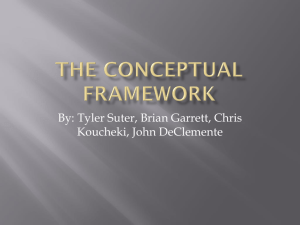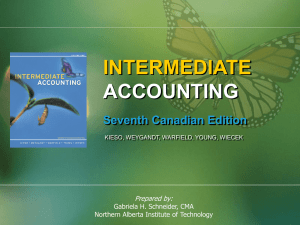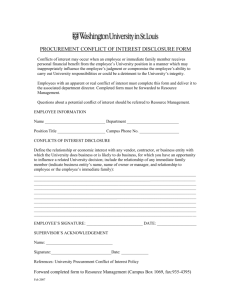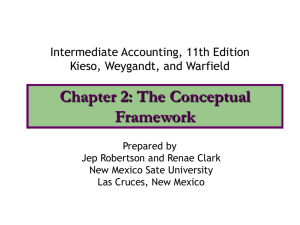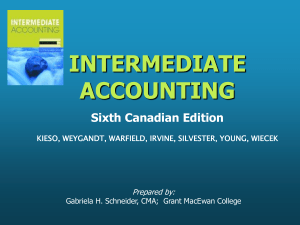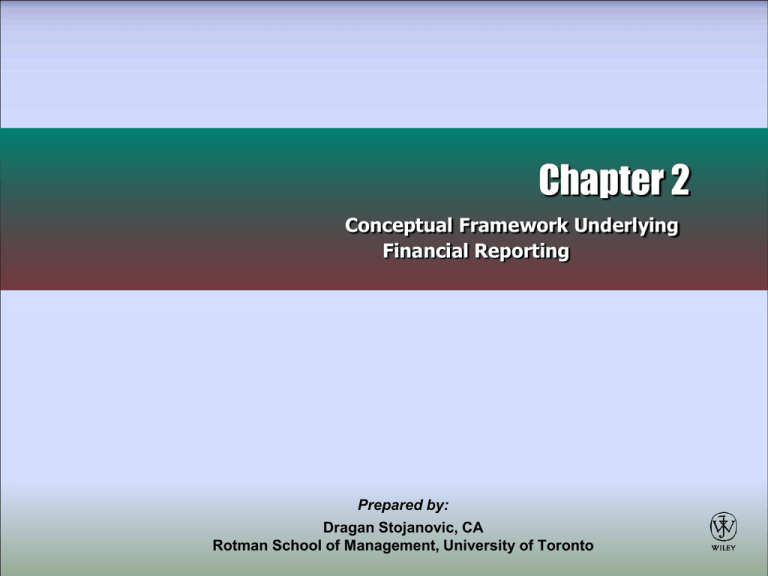
Chapter 2
Conceptual Framework Underlying
Financial Reporting
Prepared by:
Dragan Stojanovic, CA
Rotman School of Management, University of Toronto
Conceptual Framework Underlying
Financial Reporting
Conceptual
Framework
• Rationale
• Development
Objective of
Financial
Reporting
• Qualitative
characteristics
of useful
information
• Elements of
financial
statements
Foundational
Principles
• Recognition /
derecognition
•Measurement
•Presentation
and disclosure
Financial
Reporting
Issues
• Principlesbased approach
•Financial
engineering
•Fraudulent
financial
reporting
IFRS / Private
GAAP
Comparison
• Looking ahead
2
Conceptual Framework Underlying
Financial Reporting
Conceptual
Framework
• Rationale
• Development
Objective of
Financial
Reporting
• Qualitative
characteristics
of useful
information
• Elements of
financial
statements
Foundational
Principles
• Recognition /
derecognition
•Measurement
•Presentation
and disclosure
Financial
Reporting
Issues
• Principlesbased approach
•Financial
engineering
•Fraudulent
financial
reporting
IFRS / Private
GAAP
Comparison
• Looking ahead
3
Usefulness of a Conceptual Framework
• The framework is like a constitution; it is a
“coherent system of interrelated objectives”
• Creates standards for the accounting
profession
• Increases financial statement users’
understanding of and confidence in financial
reporting
• Enhances comparability of financial
statements of different companies
4
Objectives of the Conceptual
Framework
• The framework is the foundation for building
a set of accounting concepts and objectives
• The framework is a reference of basic
accounting theory for solving new and
emerging practical problems of reporting
5
Conceptual Framework for
Financial Reporting
6
Conceptual Framework Underlying
Financial Reporting
Conceptual
Framework
• Rationale
• Development
Objective of
Financial
Reporting
• Qualitative
characteristics
of useful
information
• Elements of
financial
statements
Foundational
Principles
• Recognition /
derecognition
•Measurement
•Presentation
and disclosure
Financial
Reporting
Issues
• Principlesbased approach
•Financial
engineering
•Fraudulent
financial
reporting
IFRS / Private
GAAP
Comparison
• Looking ahead
7
Objective of Financial Reporting
• The overall objective of financial reporting is to provide
information that is:
1. useful to users (e.g. Investors, creditors, etc), and
2. decision relevant (resource allocation)
• Resource allocation decisions are assumed to include
assessment of management stewardship (i.e. management
role in maximizing shareholder value)
• Conceptual building blocks (second level) include:
–
–
qualitative characteristics, and
elements of financial statements
8
Fundamental Qualitative
Characteristics
The Fundamental Qualitative Characteristics are:
1. Relevance
– Makes a difference in a decision
– Has predictive and feedback/confirmatory value
2. Representational Faithfulness
– Complete
– Neutral
– Reasonably free from error or bias
9
Enhancing Qualitative
Characteristics
Enhancing Qualitative Characteristics are:
1. Comparability
– Information measured and reported in similar way (company to
company, and year to year)
– Allows users to identify real economic similarities and differences
2. Verifiability
– Similar results achieved if same methods are used
3. Timeliness
4. Understandability
– Allows reasonably informed users to see
the significance of the information
– Provides “enough” information so that it is clear
10
Tradeoffs and Constraints
• Trade-Offs
– It is not always possible to have all fundamental and enhancing
qualitative characteristics
– Trade-offs happen when one qualitative characteristics is sacrificed
for another
• Constraints
– Materiality
• If leaving or including information would influence/change the
judgement of a reasonable person, then that information is considered
material
• Quantitative guidelines for materiality are usually made based on
income from continuing operations, assets and liabilities, or revenues
– Cost versus Benefits
• Benefits of using the information should outweigh the costs of providing
that information
11
Elements of Financial Statements
• Basic elements of financial statements include the
following:
–
–
–
–
–
–
–
Assets
Liabilities
Equity
Revenues
Expenses
Gains
Losses
12
Elements of Financial
Statements: Assets
• Assets have two key characteristics:
– They involve a present economic resource
– Entity has a right or access to those resources where
others do not
13
Elements of Financial
Statements: Liabilities
• Liabilities have two key characteristics:
– They represent an economic obligation or burden
– Entity has a present obligation
14
Elements of Financial
Statements: Equity
• Equity (net assets) represents residual interest in
assets, after all liabilities are deducted
15
Elements of Financial Statements
• Revenues
– Increases in economic resources resulting from ordinary activities
• Expenses
– Decreases in economic resources resulting from ordinary activities
• Gains
– Increases in equity (net assets) resulting from incidental
transactions
• Losses
•
Decreases in equity (net assets) resulting from incidental
transactions
– Other comprehensive income
•
Revenues, expenses, gains, and losses that are recognized in
comprehensive income, but are not included in net income (e.g.
unrealized holding gains and losses on certain securities)
16
Conceptual Framework Underlying
Financial Reporting
Conceptual
Framework
• Rationale
• Development
Objective of
Financial
Reporting
• Qualitative
characteristics
of useful
information
• Elements of
financial
statements
Foundational
Principles
• Recognition /
derecognition
•Measurement
•Presentation
and disclosure
Financial
Reporting
Issues
• Principlesbased approach
•Financial
engineering
•Fraudulent
financial
reporting
IFRS / Private
GAAP
Comparison
• Looking ahead
17
Foundational Principles
• Foundational concepts and
constraints help explain which,
when, and how financial elements
and events should be
recognized/derecognized,
measured, and
presented/disclosed
• They act as guidelines for
developing rational responses to
controversial financial reporting
issues
18
Foundational Principles
Recognition /
Derecognition
1. Economic entity
2. Control
3. Revenue recognition and
realization
4. Matching
Measurement
5. Periodicity
6. Monetary unit
7. Going concern
8. Historical cost
9. Fair value
Presentation
and
Disclosure
10. Full
disclosure
19
Recognition/Derecognition
•
Recognition
– Process of including an item on entity’s balance
sheet or income statement
– Elements of financial statements have
historically been recognized when:
1. they meet the definition of an element (e.g.
asset)
2. they are probable, and
3. they are reliably measurable
•
Derecognition
– Process of ‘removing’ something from the
balance sheet or income statement
20
Recognition/Derecognition
Economic Entity Assumption
(Also called Entity Concept)
• The economic activity can be identified with a
particular unit of accountability
• The business activity is separate and distinct
from its owners (and any other business unit)
• An individual, departments or divisions of an
entity, or an entire industry may be considered
separate entities
• Does not necessarily refer to a legal entity
• For tax and legal purposes, considered a legal
entity
21
Recognition/Derecognition
Economic Entity Assumption
22
Recognition/Derecognition
Control
• Important factor in determining entities to be
consolidated and included in the economic entity
• Some concepts of control include:
– Having power to direct entity’s activities
– Not sharing this power
– Power doesn’t need to be absolute, or even
exercised
– Access to benefits
23
Recognition/Derecognition
Revenue Recognition Principle
• Revenue is recognized when:
• Risks and rewards have passed or the earnings
process is substantially complete
• Measurability is reasonably certain and
• Collectibility is reasonably assured (realized or
realizable)
• Revenue realized when products (goods or services),
merchandise, or assets are exchanged for cash (or
claim to cash)
• Alternative contract-based view also emerging
24
Recognition/Derecognition
Matching
• Expenses are matched with revenues that they produce
• Illustrates a “cause and effect relationship” between money
spent to earn revenues and the revenues themselves
• If the expense benefits the current and future periods (and
meets the definition of asset), it is deferred
• This asset’s cost is then systematically and rationally
matched to future revenues
• There is a decreasing emphasis on matching in emerging
accounting standards
25
Measurement
• All elements must be measurable to be recognized
• Because of accrual accounting, many elements of
financial statements require the use of estimates
(and include uncertainty)
• Therefore, we must
– determine the level of uncertainty that is acceptable
for recognition
– use appropriate measurement tools, and
– disclose sufficient information to indicate/describe
the uncertainty
26
Measurement
Periodicity Assumption
• Economic activity of an entity can be divided
into artificial time periods for reporting purposes
• Most common: one month, one quarter, and one
year
• For shorter time periods, more difficult to
determine proper net income (i.e. the more
likely errors become due to more estimates)
• With technology, investors want more on-line,
real-time financial information to ensure relevant
information
27
Measurement
Monetary Unit Assumption
• Money is the common unit of measure of economic
transactions
• Use of a monetary unit is relevant, simple and
understandable, universally available, and useful
• In Canada and the United States, the dollar is assumed to
remain relatively stable in value (effects of
inflation/deflation are ignored
i.e. price-level change
is ignored)
• Monetary unit is relevant only as long as it is assumed
that quantitative data are useful in communicating
economic information
28
Measurement
Going Concern Assumption
• Assumption that a business enterprise will continue
to operate in the foreseeable future
• There is an expectation of continuing long enough
to meet their objectives and commitments
• Management must look out at least 12 months from
balance sheet date
• If liquidation of the company is assumed to be
likely, use liquidation accounting (at net realizable
value)
• Full disclosure is required of any material
uncertainties of continuing as a going concern
29
Measurement
Historical Cost Principle
• Three basic assumptions of historical cost
•
•
•
•
Represents a value at a point in time (generally
fair value at transaction date)
Results from a reciprocal exchange
(i.e. a two-way exchange)
Exchange includes an outside party
Initial recognition: for non-financial assets,
record all costs incurred to get the asset
“ready” for sale or for use (e.g. includes
transportation and installation costs)
30
Measurement
Historical Cost Principle (continued)
• Measurement is especially challenging for :
1. Non-monetary transactions (as no
cash/monetary consideration exchanged)
2. Non-monetary, non-reciprocal transactions (e.g.
donations)
3. Related party transactions – not acting at “arm’s
length” (use exchange value or cost)
• Bonds, notes, accounts payable, and receivable
recorded at “agreed upon exchange price or
economic value”
31
Measurement
Fair Value Principle
•
Fair value has been defined as
–
•
•
•
“the price that would be received to sell an asset or
paid to transfer a liability in an orderly transaction
between market participants at the measurement date”
Subsequent to initial recognition, historical cost and
fair value often differ
Fair value is often considered more relevant for
certain assets/liabilities (e.g. financial instruments)
IFRS allows the use of fair value measurement in
more situations than private entity GAAP
32
Measurement
Fair Value Principle (continued)
Fair value is a market-based measure
33
Presentation and Disclosure
Full Disclosure Principle
•
•
Anything that is relevant to users’ decisions should
be included in financial statements
Disclosure may be made:
• Within the main body of the financial statements
• As notes to the financial statements
• As supplementary information, including
Management Discussion and Analysis (MD&A)
34
Presentation and Disclosure
Full Disclosure Principle (continued)
•
•
•
Disclosed information should:
1. Provide sufficient detail of the occurrence
2. Be sufficiently condensed to remain
understandable, and appropriate in terms of
costs of preparing/using it
Full disclosure is not a substitute for proper
accounting practice
Notes to financial statements are essential to
understanding the enterprise’s performance and
position
35
Management Discussion and
Analysis (MD&A)
•
•
•
Management’s explanation of the financial
information and the significance of the
information
Publicly traded corporations are now required to
include MD&A in their annual reports
Five key elements that should be included:
1. Company’s vision, core businesses, strategy
2. Key performance drivers
3. Capital and other resources
4. Historical and prospective results
5. Any risks
36
Expanded Conceptual
Framework
37
Conceptual Framework Underlying
Financial Reporting
Conceptual
Framework
• Rationale
• Development
Objective of
Financial
Reporting
• Qualitative
characteristics
of useful
information
• Elements of
financial
statements
Foundational
Principles
• Recognition /
derecognition
•Measurement
•Presentation
and disclosure
Financial
Reporting
Issues
• Principlesbased approach
•Financial
engineering
•Fraudulent
financial
reporting
IFRS / Private
GAAP
Comparison
• Looking ahead
38
Financial Reporting Issues
•
•
•
•
Canadian GAAP is principles-based
Therefore, selecting and interpreting accounting
principles and rules relies on application of professional
judgment
Legally structuring transactions so that they meet the
company’s financial reporting objectives (while complying
with GAAP) is known as financial engineering
When pressures for reaching specific financial reporting
objectives are high, risk of fraudulent financial reporting
increases
39
Choice in Accounting
Decision-Making
40
Conceptual Framework Underlying
Financial Reporting
Conceptual
Framework
• Rationale
• Development
Objective of
Financial
Reporting
• Qualitative
characteristics
of useful
information
• Elements of
financial
statements
Foundational
Principles
• Recognition /
derecognition
•Measurement
•Presentation
and disclosure
Financial
Reporting
Issues
• Principlesbased approach
•Financial
engineering
•Fraudulent
financial
reporting
IFRS / Private
GAAP
Comparison
• Looking ahead
41
Looking Ahead
•
IASB and FASB are currently working on a joint
project to develop a common conceptual
framework
42
COPYRIGHT
Copyright © 2010 John Wiley & Sons Canada, Ltd.
All rights reserved. Reproduction or translation of
this work beyond that permitted by Access Copyright
(The Canadian Copyright Licensing Agency) is
unlawful. Requests for further information should be
addressed to the Permissions Department, John
Wiley & Sons Canada, Ltd. The purchaser may make
back-up copies for his or her own use only and not
for distribution or resale. The author and the
publisher assume no responsibility for errors,
omissions, or damages caused by the use of these
programs or from the use of the information
contained herein.
43

